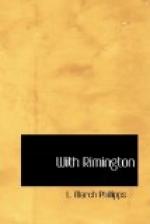Your first march with such a band is an episode that impresses itself. We were called up a few days ago at dead of night from De Aar to relieve an outlying picket reported hard pressed. In great haste we saddled by moonlight, and in a long line went winding away past the artillery lines and the white, ghostly tents of the Yorkshires. The hills in the still, sparkling moonlight looked as if chiselled out of iron, and the veldt lay spread out all white and misty; but what one thought most of was the presence of these dark-faced, slouch-hatted irregulars, sitting free and easy in their saddles, with the light gleaming dully on revolver and carbine barrel. A fine thing is your first ride with a troop of fighting men.
Though called guides we are more properly scouts. Our strength is about a hundred and fifty. A ledger is kept, in which, opposite each man’s name, is posted the part of the country familiar to him and through which he is competent to act as guide. These men are often detached, and most regiments seem to have one or two of ours with them. Sometimes a party is detached altogether and acts with another column, and there are always two or three with the staff. Besides acting as guides they are interpreters, and handy men generally. All these little subtractions reduce our main body to about a hundred, or a little less; and this main body, under Rimington himself, acts as scouts and ordinary fighting men. In fact, a true description of us would be “a corps of scouts supplying guides to the army.”
One word about the country and I have done. What strikes one about all South African scenery, north and south, is the simplicity of it; so very few forms are employed, and they are employed over and over again. The constant recurrence of these few grave and simple features gives to the country a singularly childish look. Egyptian art, with its mechanical repetitions, unchanged and unvaried, has just the same character. Both are intensely pre-Raphaelite.
South Africa’s only idea of a hill, for instance, is the pyramid. There are about three different kinds of pyramid, and these are reproduced again and again, as if they were kept all ready made in a box like toys. There is the simple kopje or cone, not to be distinguished at a little distance from the constructed pyramids of Egypt, just as regular and perfect. Then there is the truncated or flat-topped pyramid, used for making ranges; and finally the hollow-sided one, a very pretty and graceful variety, with curving sides drooping to the plain. These are all. Of course there are a few mistakes. Some of the hills are rather shakily turned out, and now and then a kopje has fallen away, as it were, in the making. But still the central idea, the type they all try for, is always perfectly clear. Moreover, they all are, or are meant to be, of exactly the same height.




